The Wind That Rolls Upon the Water (2022)

Photo by Katrina Wolfe (selected and edited from video)
The Wind That Rolls Upon the Water was a 90-minute work set in 7-limit just intonation that used direct observations of natural elements to inspire the sound, costumes, and movement. The semi-improvisatory piece was written on-location at the base of Mount Shuksan near the Lower Curtis Glacier and on the North Olympic Coast, and featured a 2-hour field recording that Joey captured during a meditation at high tide on Rialto Beach. All of Katrina's costumes for this piece were meticulously made by hand, and were designed by her to correspond with the five sections of the piece (The Wind, The Clouds, The Glacier, The Cavern, The Sea). As a result, her intricate, sculptural, and sensitive movement flowed seamlessly as a visual representation of the sound, the natural harmonics, the moods, and elements of each section.
The work was the fourth project in an ongoing series of pieces using a similar structure and instrumentation that began in 2019, each of which incorporated shifting amounts of both trained musicians and friends which had never been musically trained (but were taught their instruments for the piece). For this particular composition, a significant influence on the selection of the performers was tied to a majority having a regular meditation practice, primarily in the Theravada tradition (Burmese, Thai), but not exclusively.
Within this series, the exploration was to be able to take the foundation of an idea for a project and make subtle changes to it over time, rather than creating entirely new works. This, in some ways, mirrors the human experience, where we change subtly over time, often not realizing it until we are faced with the surreal juxtapositions that life provides us in the various forms of suffering we've all grown to know and love. A powerful definition of this can be found in the Dhammacakkappavattana Sutta:
“...birth is suffering, aging is suffering, illness is suffering, death is suffering; union with what is unpleasant is suffering; separation from what is pleasant is suffering; not to get what one wants is suffering..."
Performed by Annapurna Dharma Communion
December 2nd, 2022
Chapel Performance Space, Seattle
Jackie An - violin
Michael Shannon – cello, voice
Katrina Wolfe – movement, costumes, choreography
Manasvi Patel – 7-limit shruti box, bamboo chimes, copper chimes, bells
Sam Vanderlinda – 7-limit shruti box, steel tongue drum, bells, tibetan bowls
Joey Largent – cello, voice, field recording, composition
Russell Christenson – 7-limit harmonium, bells
Basaltic Void Dervishes (2021)
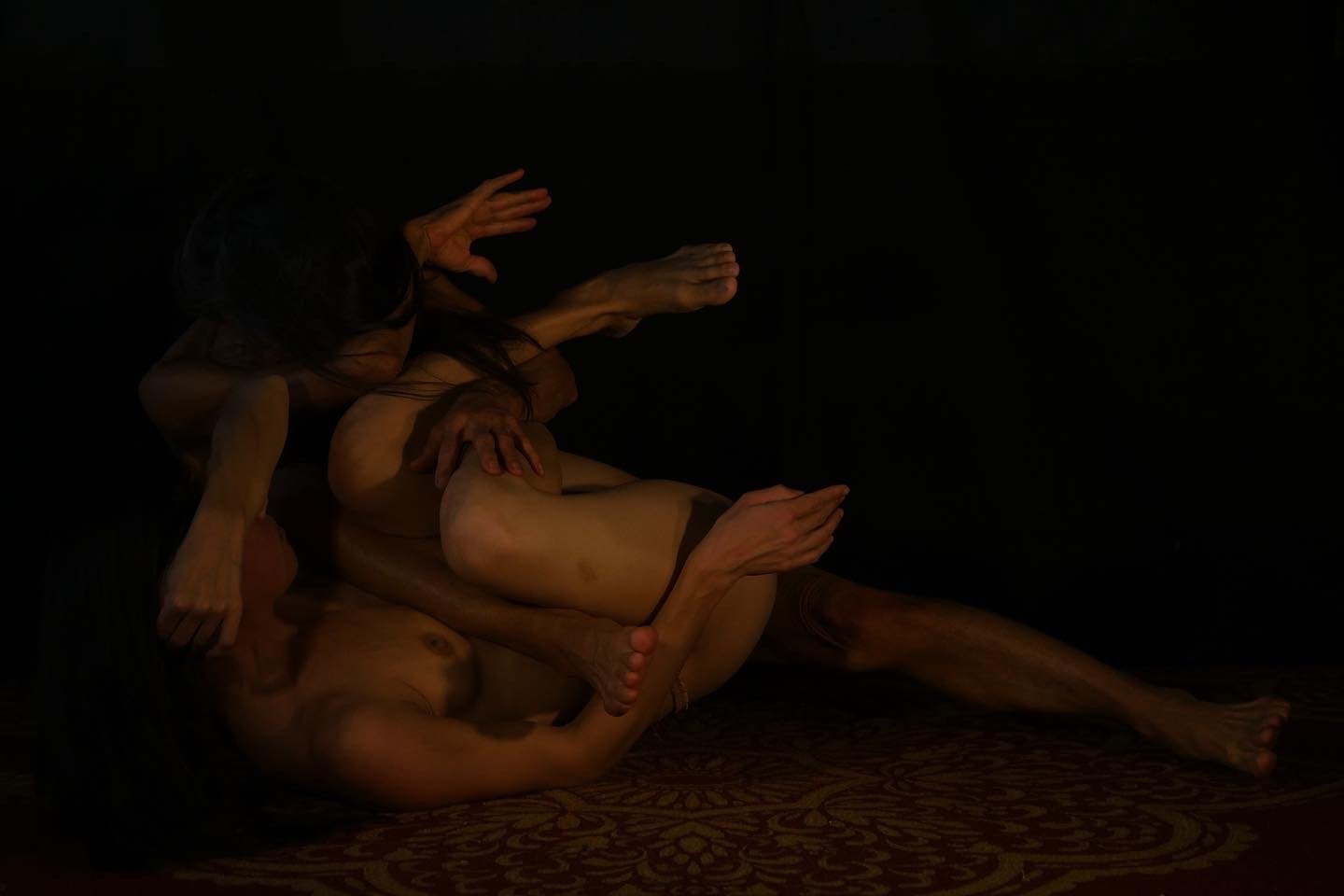
Katrina and Kawtee in rehearsal; photo by Joey Largent
Basaltic Void Dervishes was a 3-hour durational performance at Chapel Performance Space in Seattle, Washington on December 4th, 2021. The work was performed live using ten malleted, closely mic'd cymbals in a semi-improvisatory format (using memory and some pre-determined cymbal combinations) combined with an unending field recording of cave dripping from Falls Creek Cave. Movement artists and mother/daughter duo Katrina and Kawtee Wolfe performed their delicately shifting improvisatory movement for the entire 3-hours in collaboration. The work was performed in near darkness, with no light other than five candles lit around the dancers. The audience sat on a large installation of rugs and floor pillows (with chairs in the back for those who needed them) and was free to come and go at any time during the performance.
Seven Dreams of the Nooksack Glacier (2021)
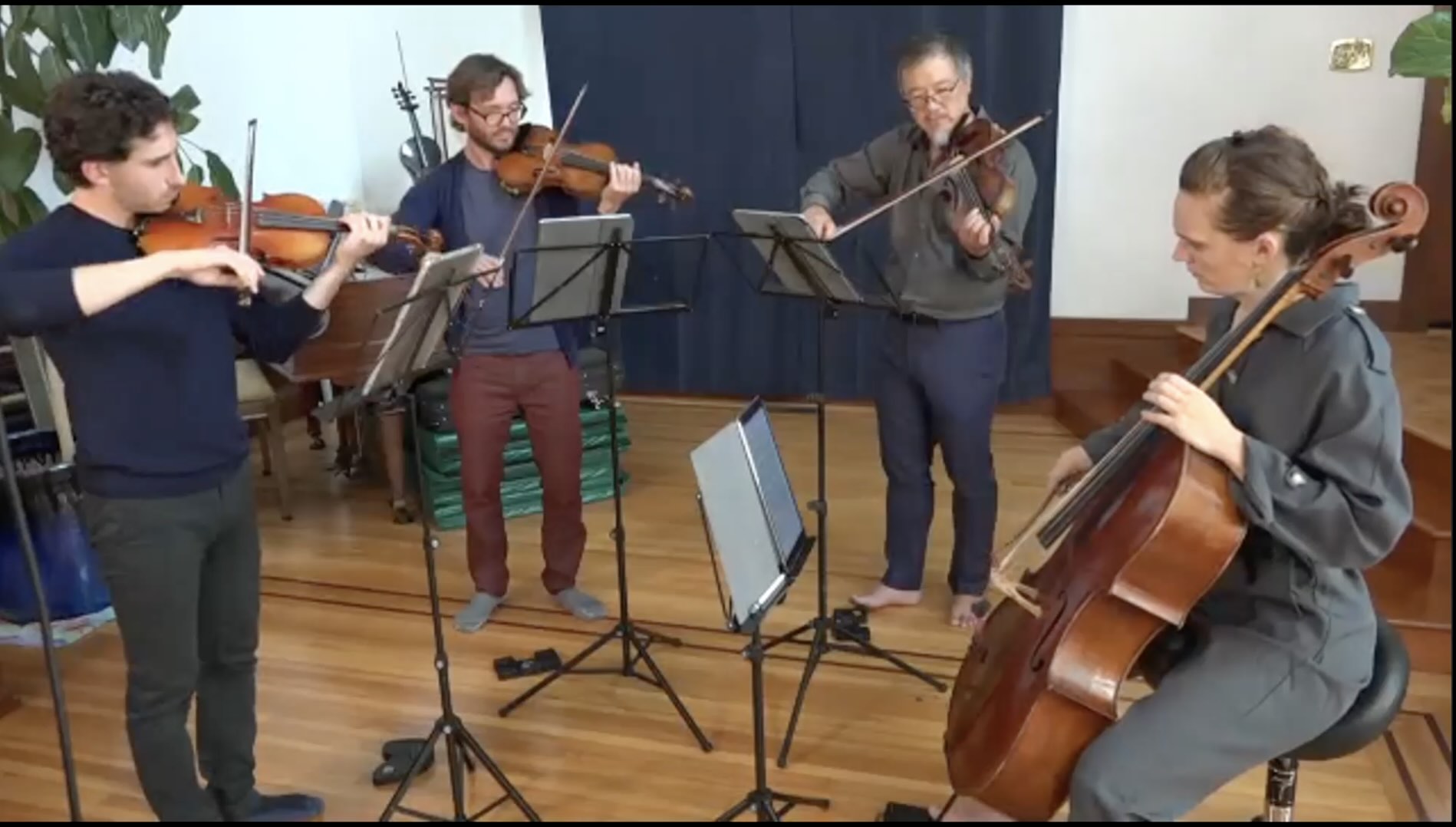
The work was originally intended to be an explorational sketch written to explore the sonic movements of glacial systems from Mount Shuksan in the North Cascades in Washington State. For now, it remains a stand alone project. The Nooksack Glacier just intonation tuning is derived from a hybrid of Raga Darbari and the dorian mode (with a flat 6th degree), a modal system that I have worked with for several long-form pieces over many years. The system primarily includes septimal intervals for half steps, pythagorean intervals for the remaining notes, and a sharp septimal fourth included in the scale (the only interval to be mathematically acquired using the 5:4 [major third] interval; the rest rely on 7:4 and 3:2 relationships).
The work weaves in and out of many worlds, exploring long-form relationships of sustained pure harmonies and movements that derive from my studies in khyal of the Kirana Gharana, specifically through movements learned from Rose Okada when being taught Raga Darbari in the tradition of Pandit Pran Nath, Ustad Hafizullah Khan, and Ustad Mashkoor Ali Khan; and undoubted influence from my love of the work of La Monte Young. Due to much of his work being unreleased or only performed live - especially his compositions for strings - I've found myself imagining and fantasizing about what his work must have sounded like, and finding my own inspiration out of that headspace.
The piece premiered as a live streaming on October 24th, 2021 and was performed in 7-limit just intonation by San Francisco-based Del Sol String Quartet as part of Arts Letters & Numbers CMO 2021 Workshop + Residency, directed by Michael Harrison. A deep and special thanks goes to Kathryn, Charlton, Sam, and Ben of Del Sol for working with me on this, and to Michael for all his help in guiding me through its development.
Dreams of the Forty Whales of the Harmonic Reed System (2021)
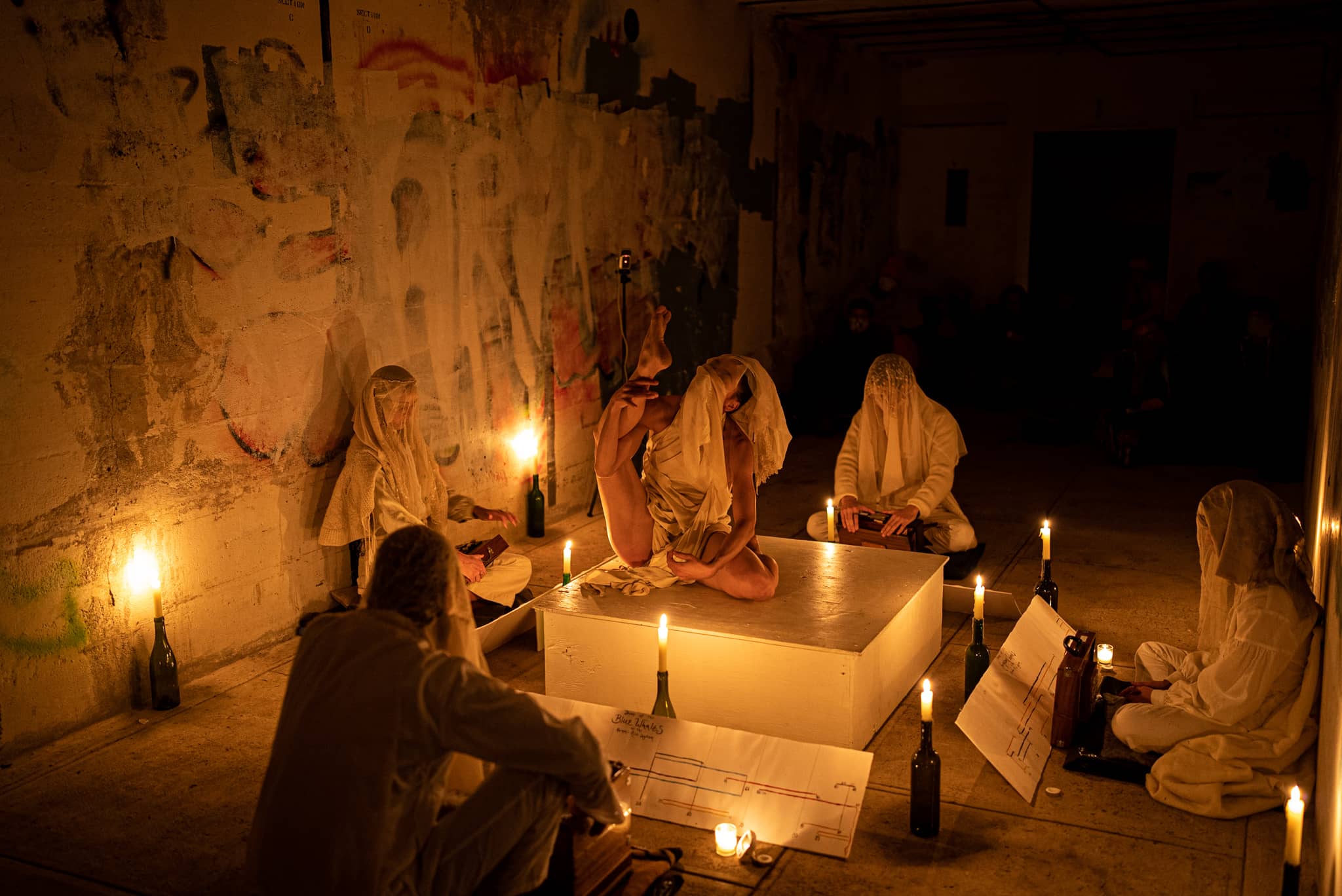
Photo by Kawtee Wolfe - Fort Worden State Park
Dreams of the Forty Whales of the Harmonic Reed System was a 90-minute composition for three shruti boxes and one harmonium retuned into 17-limit just intonation performed by Glacial Time Communion. The piece was scored non-traditionally with hand-crafted graphic scores of paint and sumi ink on paper. The scores consist of lines of color on the horizontal axis that corresspond with colors on the shruti box valves. On the vertical axis is time. This allowed the piece to be accessible to anyone who could learn to play shruti box. The composition was paired with movement by Katrina Wolfe, which both visually highlights the shifting shapes of the natural harmonics and allows time to pass at a different rate. The piece was performed three times.
The first performance was inside of Battery John Brannon in Fort Worden State Park, Port Townsend, Washington on October 2nd, 2021, featuring Danielle Quenell (7-limit shruti box), Taehyung Kim (17-limit shruti box), Sasha Leon (7-limit shruti box), Joey Largent (7-limit harmonium), and Katrina Wolfe (movement).
The second performance was at Chapel Performance Space in Seattle on August 14th, 2021, featuring Danielle Quenell (7-limit shruti box), Taehyung Kim (17-limit shruti box), Kaliane Van (7-limit shruti box), Joey Largent (7-limit harmonium), and Katrina Wolfe (movement).
The third performance was at Artlab Thuja in Chimacum, Washington on April 19th, 2024, featuring Sam Vanderlinda (7-limit shruti box), Kawtee Wolfe (17-limit shruti box), David Noble (7-limit shruti box), Joey Largent (7-limit harmonium), and Katrina Wolfe (movement).
Below Diorite Waters (2021)

Photo by Joey Largent - Main passage of Falls Creek Cave, Washington State
“Dragon’s Eye Recordings is excited to announce 'Below Diorite Waters,' a new long-form work by Joey Largent. On 'Below Diorite Waters,' Largent presents two site-specific recordings of seven closely-mic'd cymbals in an isolated mile-long lava tube of the Falls Creek Cave system near Mt. St. Helens. Largent’s method allows the natural overtones of the cymbals to emerge, creating layers of harmonics above the continuous rolling of mallets and perpetual drip of cave water."
Developed over the course of two years, ‘Below Diorite Waters’ was released by Dragon’s Eye Recordings in Los Angeles on March 19th, 2021.
More info about this piece can be read in the PDF booklet accompanying the album. Although the physical copies are sold out, email me if you'd like the PDF :-)
Levitation Practice for the Sublimation of Time in the Modal System of the Maroon Glacial Cirque (2020)
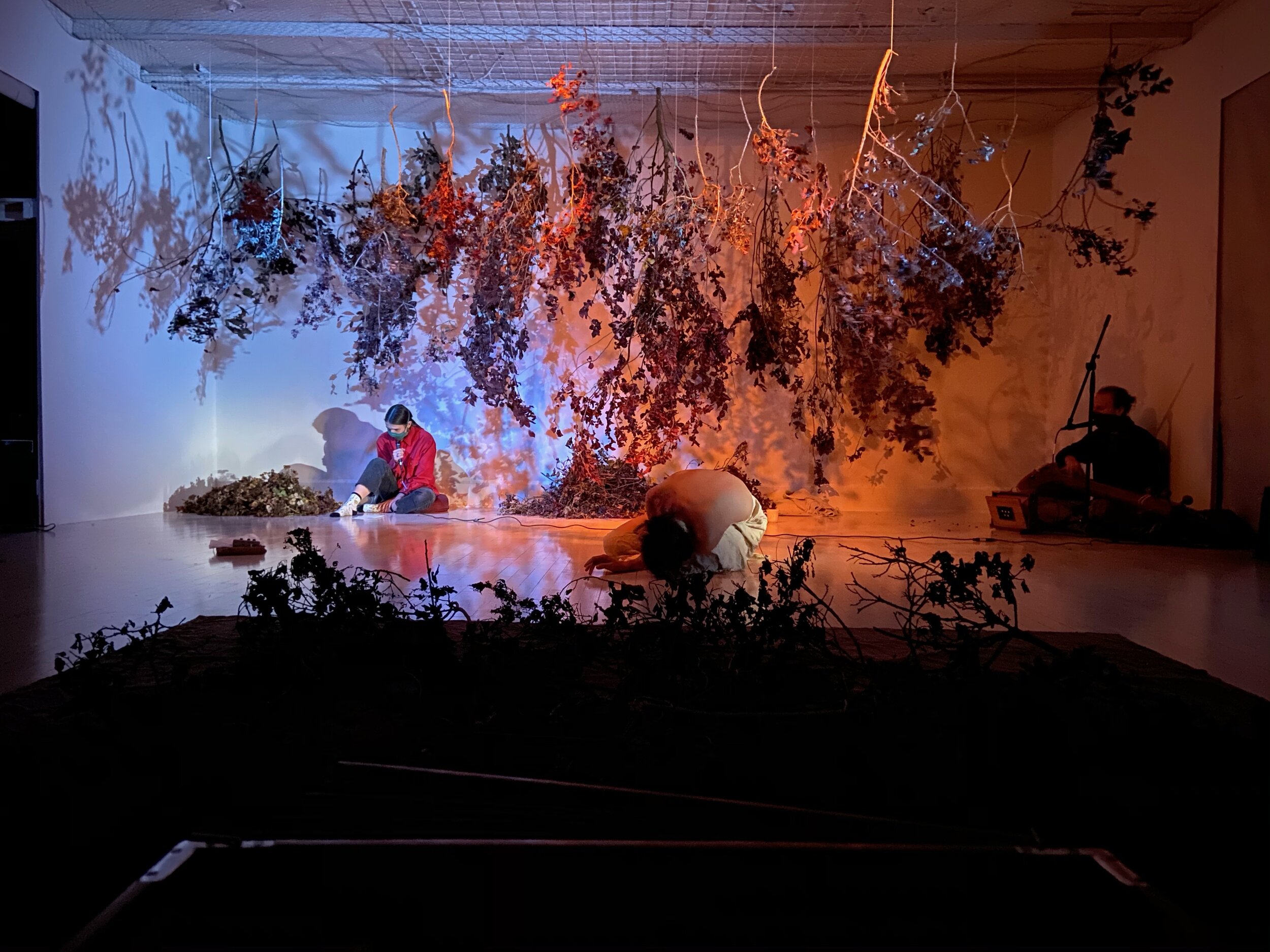
Photo during rehearsal by Russell Christenson
This two-hour work was a variation of an ongoing “durationless” composition series featuring a 6-piece acoustic ensemble drifting delicately in the expansive Raga Miyan ki Malhar. The structure of the piece created form while offering space for individual improvisations. The audience was placed in the center of the room, immersed by musicians and sound. The work was performed underneath Katrina Wolfe’s hanging installation of purple smoke and vine maple branches. Due to Covid restrictions, the audience amount was limited to 7 attendees, offering the rare chance for attendees to be outnumbered and surrounded by musicians.
Performed by Dhikr Allah Ensemble
November 3rd, 2020
Studio Ma, Seattle, Washington
A celebration in honor of the 102nd birthday of Pandit Pran Nath
Katrina Wolfe - movement, installation
Joey Largent - amplified voice, tambura, shruti box, composition
Michael Shannon - erhu, voice
Noel Kennon - viola, voice
Danielle Quenelle - shruti box
Taehyung Kim - 7-limit just intoned shruti box
Russell Christenson - harmonium
Selected Drift in Dream Stasis (2020)
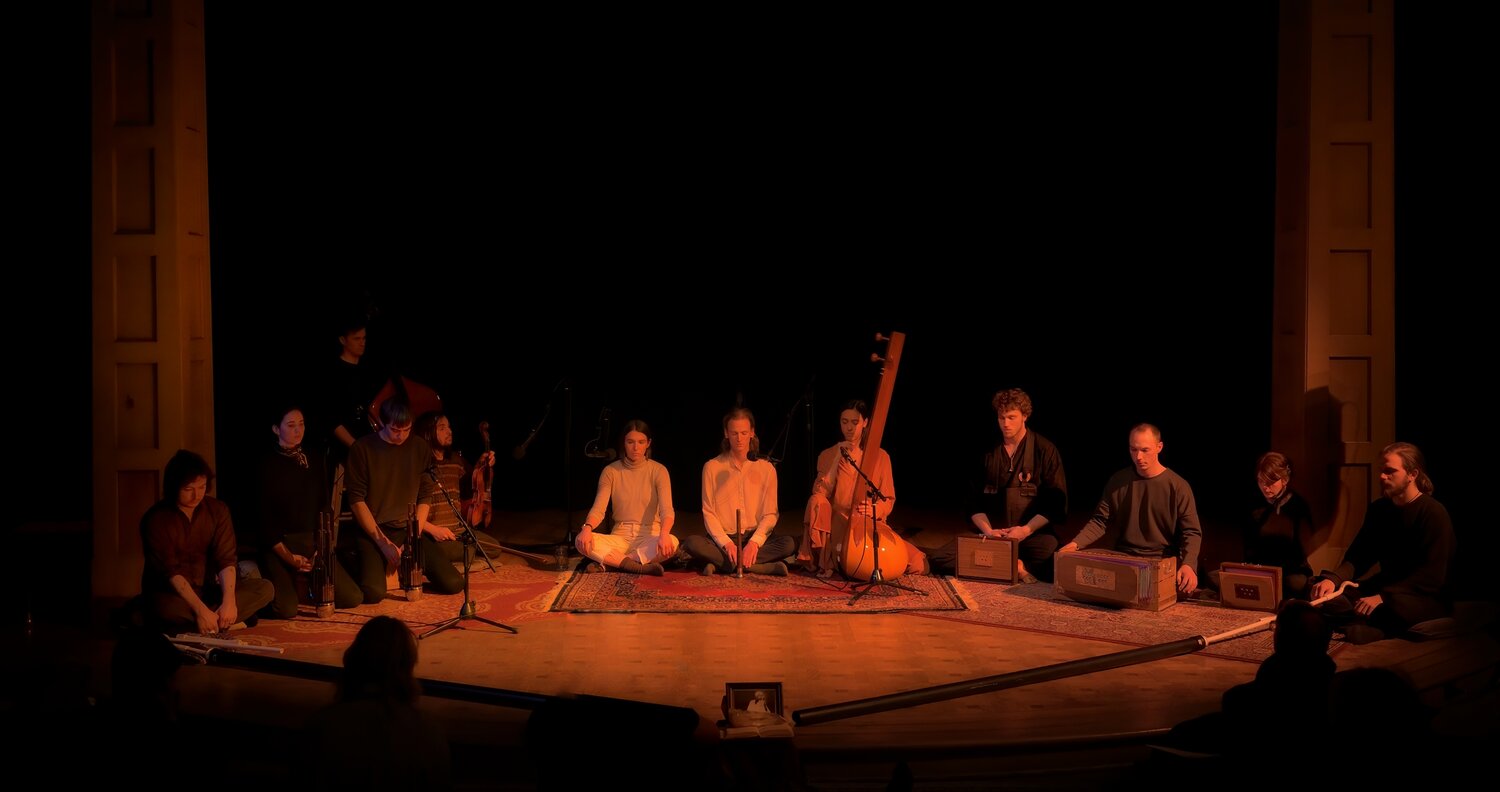
Photo by Joe Iano
Selected Drift in Dream Stasis was performed at Chapel Performance Space in Seattle on January 17th, 2020. The piece featured an ensemble of 12 artists from various disciplines playing selected instruments from across the world. The piece was not timed, and lasted nearly two continuous hours organically.
This piece was a long-form work exploring ideas connected to the elimination of time and thought. Through slow, delicate movement, the piece expanded to shape an environment that sought to invite both the performers and listeners to dissolve into a state of spiritual unity, or, deep stasis. Composed in a dissonant combination of just intonation and equal temperament, the piece attempted to weave pure intervals and harmonic beating amongst the ensemble, utilizing a single continuous layered drone of acoustic instruments with variable frequencies and qualities. Although the work may have seemed to be primarily a sonic experience, it was just as much a practice the physical body. Applying theories and methods derived from study of Butoh, Sufism, and meditation, the work sought to integrate the awareness of the body and breath equally with sound.
With no fixed duration, the work found movement through performer intuition to cue changes within the composition, possessing the ability to last between 30 minutes, 4 hours, or even continue indefinitely. The composition was inspired from Pandit Pran Nath’s 12-note tarana in Raag Bhairavi, Dira Dira Ta Na. The remaining movements and qualities of notes were improvised by the individual performers.
With an emphasis on feeling/intuition as the primary driver of the work, artists with strong intuitive/feeling capacities were selected to make up the ensemble, some with little or no knowledge of the instrument they were given to play, and some with no musical background. This was a primary, critical choice to maximize the effectiveness and cultivation of an immersive feeling-based environment, and to display the universalizing quality, accessibility, and divinity of sound and eternal drone.
The performance was held under warm, dim light on an ornate installation of rugs and floor pillows. Listeners were encouraged to bring blankets and items comfortable to them to the space.
Performed by
Dhikr al-Fana’ Time Communion
Joey Largent – solo voice, shehnai, composition
Jocelyn Beausire – solo voice
Katrina Wolfe – Riley/Leedy Miraj tambura
Noel Kennon – viola, voice
John Teske – double bass
Sasha Leon – sheng, drone voice
Kyle Griesmeyer – sheng, drone voice
Sam Tullman – shruti box, drone voice
Danielle Quenell - shruti box, drone voice
Russell Christenson – harmonium, drone voice
Zack Wait – just intonation reed horns, shehnai, drone voice
Brendan McGovern – just intonation reed horns
Levitation Practice in the High-Order Modal Stasis of Semâ (2019)
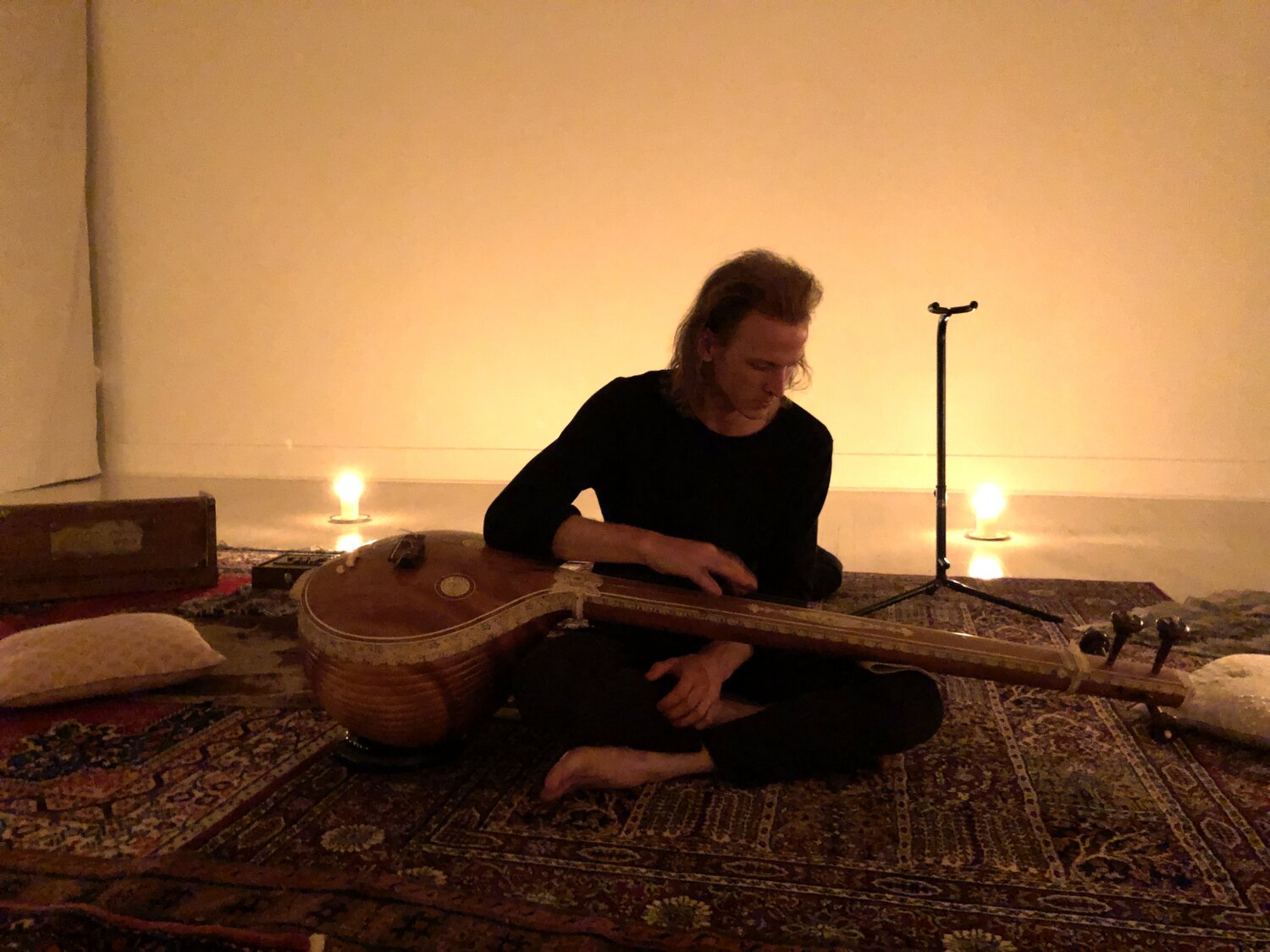
Tuning the tambura - Photo by Tae Kim
This first Levitation was a two-hour piece performed on June 13th, 2019, the anniversary of Pandit Pran Nath’s death. The performance was part of an evening to celebrate Pran Nath's life, also featuring Noel Kennon's performance of a two hour piece for sine tones and voice.
Levitation was a test of sorts, as Russell had no musical experience, and Tae and Katrina had some from their past. Noel, Jocelyn and I were the only technical musicians to perform the piece, yet it carried many into a sort of trance state, as I was told afterward. The test was to form an ensemble made up of a few musicians but also of artists and individuals with little to no experience or current practice. This led to the formation of the ensemble in Dream Stasis and many others to come.
I always believed that the test was successful. Unfortunately, we were not able to capture many photos or video from the event or video. The photo above was taken by Tae Kim while I was tuning the tambura shortly before the piece (which we borrowed from a friend for the show). Thankfully, Tae captured a recording of the whole thing on his phone, which ironically turned into a beautiful recording of the piece.
The piece was written for two to six voices, viola, tambura, harmonium, and shruti box, and lasted about an hour and a half with no time limit. Partially composed in just intonation, the inclusion of the harmonium and shruti box added both fullness to the piece, yet disrupted the pure intervals formed between the harmonics of the tambura, voices, and viola. This inclusion provided an intentional dissonance to the piece to create a custom modal scale of endless wandering, similar in many ways to Raga Todi. The performers were given the notes and a loose structure for the whole piece, but no fixed direction on movements, timing, and dynamics. Even though, as I mentioned, some of the performers had little to no musical background or recent musical experience, their selection in the ensemble was based solely on their heightened and beautiful intuition and feeling-based ability above all else. The piece was arranged like a slow wave, growing to its peak, then coming to resolve. These intentional choices were incorporated to allow the performers and listeners to have access to drifting into a deep state of divine union and resolve, similar in many ways to the states of samadhi found through actions like meditation, for example.
The piece was intended to be meditation on impermanence, non-attachment, equanimity, and continuous body of clarity and not-knowing, transient individual dreams of self and selflessness, sonic/physical exploration of zero/no-time void.
Performed by
Ensemble Dhikr Allah
Jocelyn Beausire - voice
Joey Largent - voice, composition
Katrina Wolfe - tanjore tambura
Noel Kennon - viola, voice
Russell Christenson - harmonium, voice
Tae Kim - shruti box, voice
An Offering (2019)
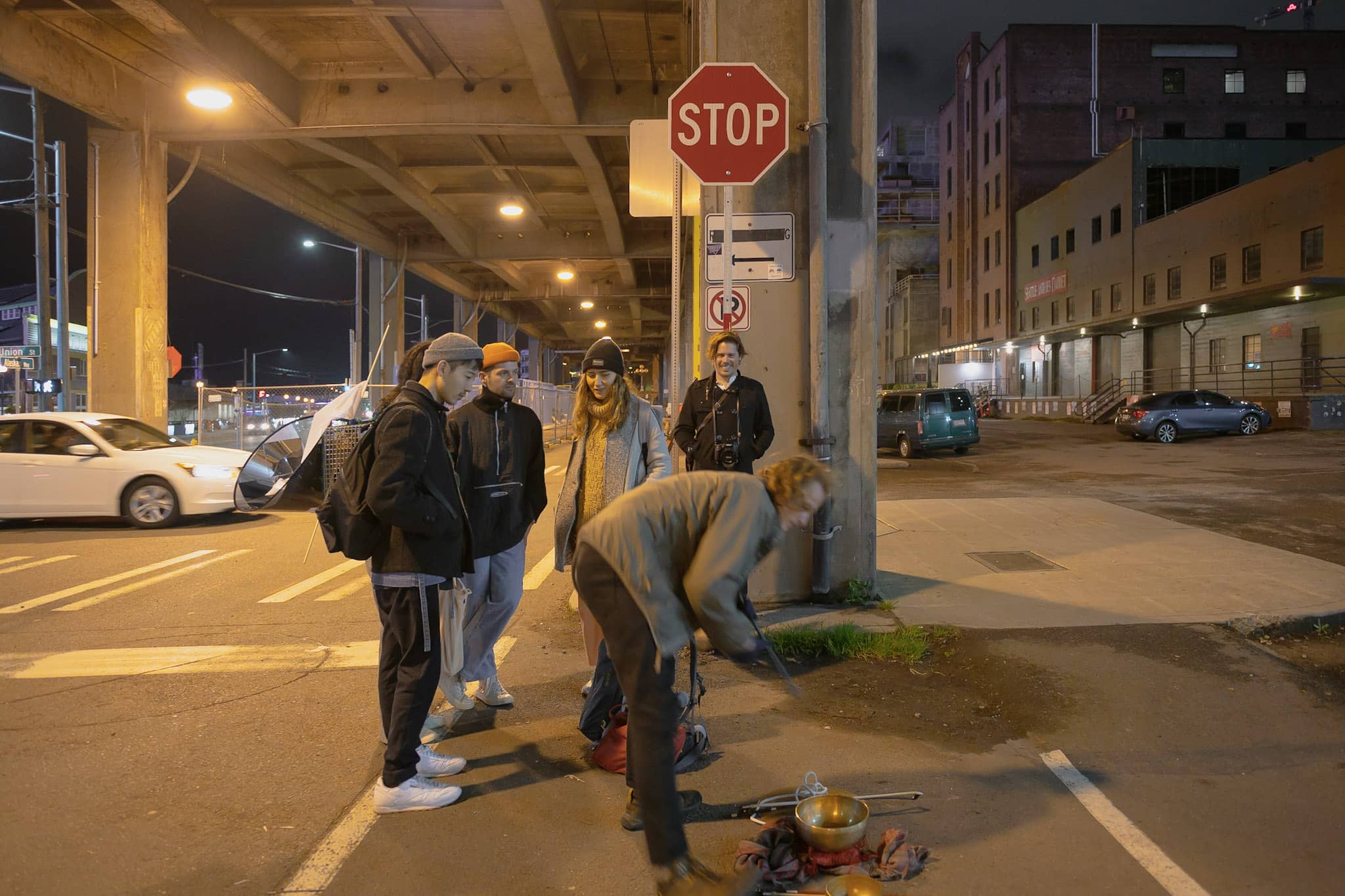
Photo by Thanasis Ikonomou
On February 2nd, 2019, Signe Ferguson invited nine conceptually-minded artists and friends to create a series of programs--known as the Procession of Ten--involving the soon-to-be-demolished Seattle viaduct (a structure that presented a gorgeous driving view of the mountains and sound, but also posed earthquake hazards). Signe reserved several free tickets for us, as the roadway was to be opened up for walkers to process across one final time. Each of the ten participants was to develop a program that both involved each of the nine others and connected to the viaduct in some way.
An Offering occurred at the very end of the long, eventful day of interacting with many humans and sharing our varying ideas and programs with each other. They had closed the viaduct and tunnel to walkers by the time we had gotten to the tenth person's program (mine), and so we wandered away to a more intimate, public, less-theatrical place, losing some of our original participants in the process, and gaining some new ones.
The project to develop an offering was a multi-layered one featuring more elements of ritual than any practicality. The idea of creating an artwork to celebrate a giant concrete mass put me off in many ways, but I enjoyed and was excited by the challenge. I wanted to transcend the architecture somehow, show that there is a natural world deeper than this grey, concrete city.
The first step in this project involved traveling to several sites across the Puget Sound that were visible from the viaduct--West Seattle, Bainbridge, to name a few. Once there, I captured field recordings of the locations, all of which featured water in a significant form. I then compiled these field recordings into layers on top of each other based on location, and assigned each location to a separate bluetooth speaker. At the moment of the piece, each participant was first to put out their hands to be washed by the water of two converging wakes (there is a cut on Bainbridge where this happens), and then given a small scroll. Each scroll had listed on it a certain feeling (i.e. a difficult memory from childhood), and when this feeling comes up for the participant (and naturally it will, as once they see the scroll, they begin thinking about the topic) they play their instrument for the duration of the thought. Each person was also given a stick of traditional Japanese zen temple incense to burn. Once the scrolls and incense were given, the participants were to select their instrument. After this, they were all instructed to relax, focus on their breathing, the thought, and the coming and going of it, and to walk forward gently, counting about three seconds between each step.
Once we began, it was a beautiful experience—-one that is hard to put into words. I remember feeling a slight irritation when hearing one of the participants constantly ringing a tiny bell--similar to the sound of the Salvation Army people. When I asked afterward what was going on, he told me what was written on his scroll: "feeling connected to someone you do not know." He was one of the folks that joined our group at the very end, and none of us knew him. He said the feeling never stopped for him, hence why he rang the bell continuously. It was a beautiful feeling.
I never wrote down the names of everyone involved in this final act of the procession at the time, and all I have is this photo and recording left. Based on the photo, it was: Tae Kim, Thanasis Ikonomou, Gaby Czarniak, Signe Ferguson (she may have left already), Phoebe Rhinehart, Mika (sp? never got his last name either), and Gavin Argo.
There Was a Time That I Knew You / Third Cast of Burdock Light / It Was in Dreams That We Knew Each Other (2018 - present)
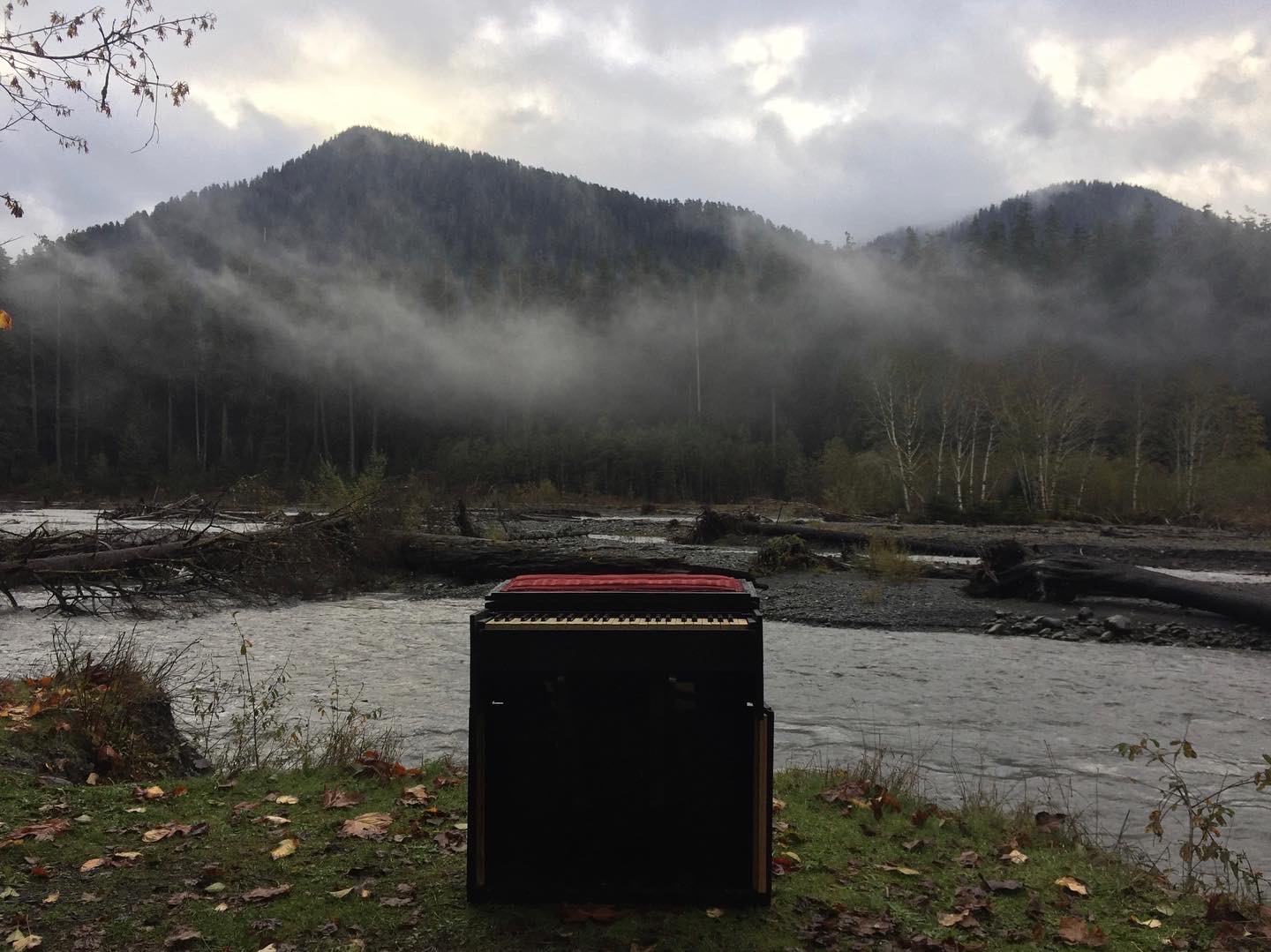
Recording the first version of the piece (2018) - Hoh Rainforest, Washington State - photo by Joey Largent
This piece, having many names, was originally composed on an 1875 Taylor and Farley reed organ when I first came to Seattle in the winter of 2018. Over this course of time, I began to add new parts to it, and, after giving away the giant parlor organ (which had serious bellow leaks), I primarily worked on and performed the piece on a portable 1930/40s Estey reed organ. I continued to add and remove parts over the years that, in theory, would have allowed the composition to be played for an infinite amount of time.
At one point, the work was comprised of two sections.
The prelude, There Was a Time That I Knew You, was composed in a similar style to the primary composition, containing infinitely changing parts. My friend Signe had come into temporary possession of a studio space in central Capitol Hill in Seattle, which she named The Annex. She had invited me to give the inagual performance at the space, and I accepted to do it with this organ piece. This part was presented as a durationless performance (meaning I had no timer/time limit and improvised within the parts and let it end organically) in March 2019, and lasted about an hour and a half untimed. The work was paired with field recordings captured on the Oregon coast while observing a whale migration.
I performed the primary composition, Third Cast of Burdock Light, on the Estey reed organ for the first time in its early stage while camping in the Mojave Desert, and shortly after for performances in Los Angeles, San Francisco, and Bellingham during a short Earth Drones tour. I recorded the first quarter of the piece in early winter of 2018 in the Hoh Rainforest (pictured above).
Both sections were comprised of a variety of segments that could be played at any time in the piece, varying in length, weaving, repeating, contrasting, expanding, inverting on intuition-based changes of a non-linear spectrum.
Later on, in September of 2019, I performed the work for three continuous hours at a small concert at Studio Ma in Seattle alongside the whale migration field recording of waves. Only four people came throughout the entire concert, but it was special to me.
everything is connected
The organ was originally manufactured to be used by ministers during World War II, and is tuned to equal temperament with A=420. The ideal tuning of the organ was always to be in just intonation, using whole number ratios to tune the reeds to a custom scale that reflects the composition, which would allow the overtone series to fully resonate, and for the voice and organ to be in a pure harmonic relationship. However, for a long time, I could not figure out how to access the reeds to achieve this.
In the Fall of 2023, I decided to try again and basically took the organ apart, only to discover that the reeds were easily accessible, tunable, and in great condition. I drafted a just intonation tuning for the organ to accompany the work, and performed a 45-minute improvised version of it at Chapel Space in Seattle on October 7th, 2023 in a double concert alongside Nat Evans and his ensemble. For this performance, I used a two-hour field recording from Rialto Beach to accompany the piece (the same one used in The Wind That Rolls Upon the Water). By this time, the two parts were condensed into one piece, and I renamed it once again.
However, in this concert, I realized the piece was still missing direction, and by allowing it to continue to exist as an infinitely expanding work it would always feel incomplete. Afterwards, a series of deeply emotional experiences occured to me, I was able to finish writing the lyrics to the piece, and finally organized the parts in a fixed format that felt just right to me.
I returned to a spot next to the Hoh River in November of 2023 and recorded the hour-long work. It has a new name and will be released one day soon :)
Earth Drones (2018)
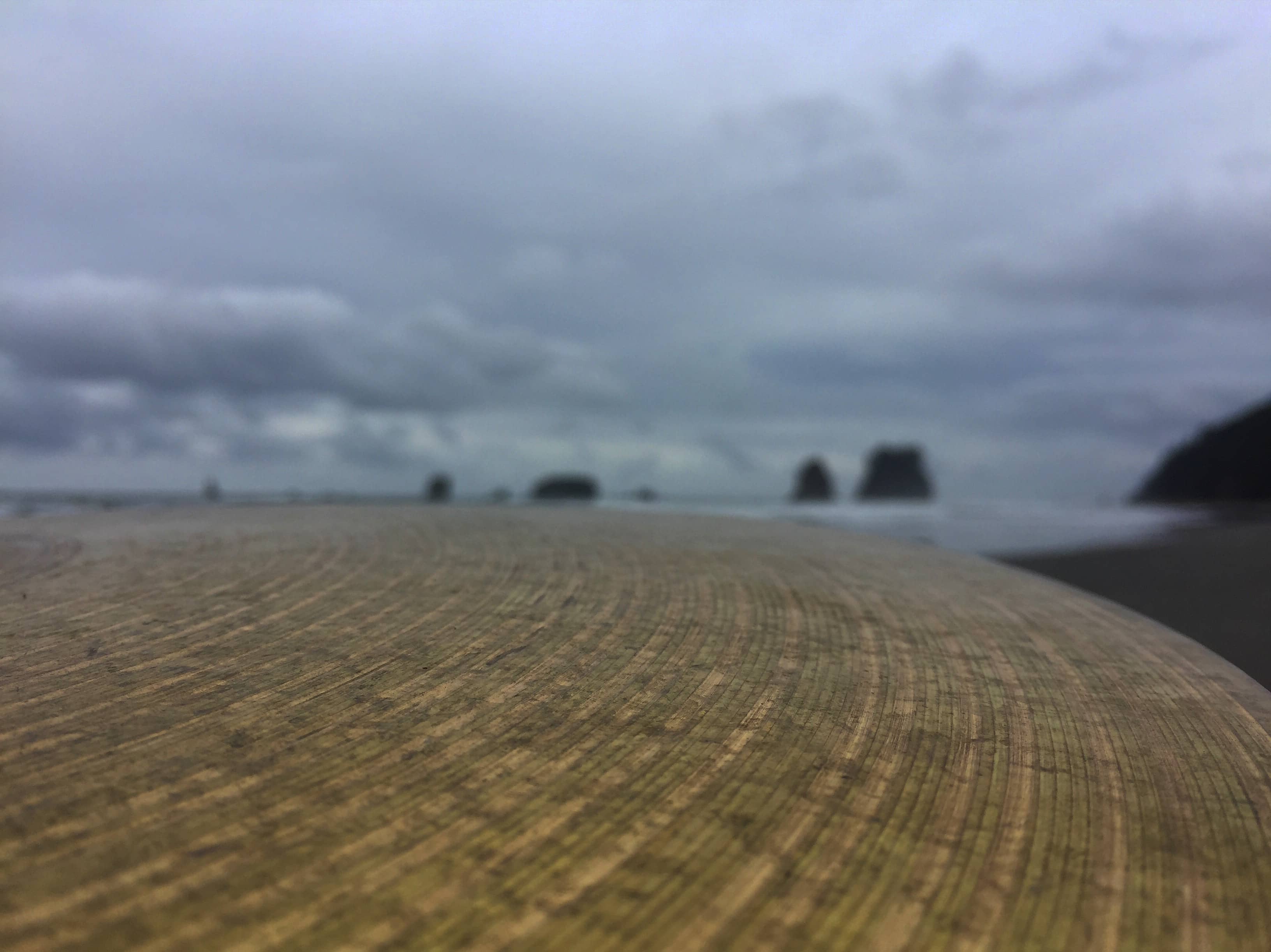
Recording Impermanence - Photo by Joey Largent
"With meditations in structure, sound transference through the body, spatial influence on compositional development, and field recording improvisation, Earth Drones is Largent's initial exploration of durational performance, excavation into layers of consciousness, and void exploration through experiments with context-based recording and sound density. Recorded across three states that possess generational memory and connection (Arkansas, Missouri, Washington), each piece explores a different aspect of the primordial relationship of the mind to the body, the vessel that is the body, and the connection between the vessel and its natural surroundings. Combined with this, the work explores the manipulation of the sonic frequencies of four acoustic instruments (harmonium, shruti box, three cymbals, drums) in order to heighten the listening environment for reflective explorations of time, memory, and depths of psychological reverberations."
This album was recorded at a time of immense transition for me--I had just ended a four year relationship, I was naively in love but still incredibly damaged on the inside, I moved into a house with a friend on Beaver Lake in Monte Ne, Arkansas, I had decided to leave Arkansas after 23 years and move to Seattle. During the time of recording this entire album I was in a heightened state of transition where nothing in my life was settled and I was searching for meaning. I felt so vulnerable and insecure inside, and needed to prove to myself that I was capable of creating something deep and meaningful. Many of those close to me over the years have commented on the 'beautiful tragedy' they feel in the album. In fact, this is very acutely observed, as the entire album was recorded while essentially processing the grief of change and becoming someone whole after losing oneself entirely with someone else.
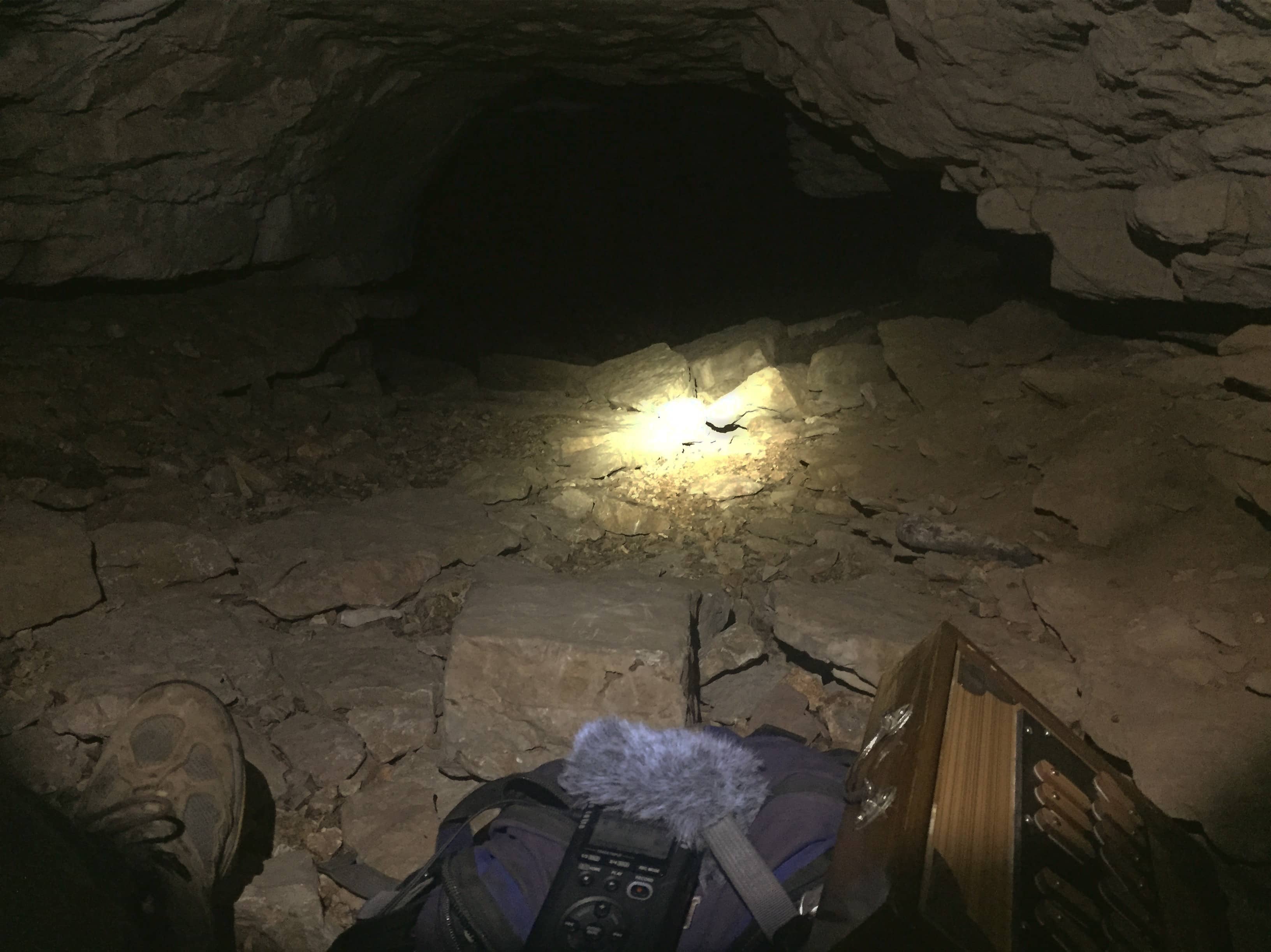
Recording Tourmaline Resonance - Photo by Joey Largent
This album, and later, Below Diorite Waters, were monumental experiments in testing my own courage and reforging my relationship with myself after I had lost the meaning of what this was. This unscores the practice of field recordings, as all of these were done in complete aloneness, and in some situations (such as in "Impermanence"), there was a deep fear and vulnerability being overcome while camping completely alone in nature, exposed to wild animals throughout the night in a new landscape I didn't yet understand.
Arrival on the Bardo Plane (2017)

Recording cymbal experiments next to Eye of the Needle, Ponca, Arkansas - photo by Joey Largent
Arrival on the Bardo Plane was the beginning of a long sequence of important conceptualizations. The work consisted of two closely mic’d cymbals recorded at a high volume. Simply soft tappings of the cymbal would generate a rainbow of natural overtones. In realizing this was possible, this led to numerous experiments with the practice. The recording was made at a lake house I was living in for a few months in Monte Ne, Arkansas before moving to Seattle. The recording was supported by my friend Ryan Cockerham, who also mastered the track and released it under his label at the time, Double Dream Records, though later on I did a small self release of the 8-minute track. The photo above is from an experiment that I did after recording the piece, traveling to a remote section of the Indian Creek trail in Ponca, Arkansas. I found a small cave at the top of a bluff to do a recording, which yielded mesmerizing results leading to a cascade of experiments with amplified cymbals, primarily my 2020 album, Below Diorite Waters.
Selected Minor Works (2018 - 2011)
Psalm of Her Time (2018):
solo 1872 Taylor & Farley reed organ - 15'
Suspended by a Faint Blue Light of Consciousness (2018):
malleted custom cut cymbal, malleted 1920s chinese wu-han crash, recorded at the ice caves at Big Four Mountain near Granite Falls, Washington - 9’
Purified By the Light (2018):
solo Indian harmonium - 10'
When I Saw You (2018):
solo 1872 Taylor & Farley reed organ - 10'
16728 Harmon Road (2016):
voice, floor tom, two bowed cymbals
Released digitally on the compilation Ambient Arkansas [released on Aural Films] - 5.5’
The Path of Good Wishes Affording Protection from Fears in the Bardo (2015):
spoken reading of the named section of the Bardol Thodol, accordion - 10’
Self-released digitally on the album Dreams (2015)
Song of Earth (2015):
for layered voice - 8’
Self-released digitally on the album Dreams (2015)
The First Dream of My Brother (2015):
bowed cymbal, for Solomon - 7’
Self-released digitally on the album Dreams (2015)
A Brief Recollection of Transcendence (2015):
extended field recording passing Redmond’s Candy Factory on i44 outside of Lebanon, Missouri - 14’
Self-released digitally on the album Dreams (2015)
Constellations (2015):
selected frequencies of three snares - 8’
Self-released digitally on the album Dreams (2015)
Time Between Three Points (2015):
for accordion, voice, to be played in Mount Sequoyah Woods, Arkansas in spring - 7’
Self-released digitally on the album Dreams (2015)
Alborz (2014):
accordion, violin, voice, flute, contrabass - 3.5’
Türk Düğünü (2013):
davul, zurna - for any duration
Ground Me, Spirit, Show Me to Love (2013):
layered voice - 5.5’
Self-released digitally on the album Prana (2013)
Spirit / Eye (2013):
percussion, two voices, Indian harmonium, bells, dan moi - 12.5’
Self-released digitally on the album Prana (2013)
The Farthest Thing You Can See (2013):
piano, voice - 5'
In Swarupkathi (2012):
Indian harmonium - 13'
Vibrations from Swarupkathi (2012):
Indian harmonium, frame drum, percussion - 11.5’
Chrysalis (2012):
for three shruti boxes, two voices - 4.5’
Varuna (2012):
floor tom, Indian Harmonium, voice, bass drum, cymbal, bells - 5’
Chand Baori (2012):
Indian harmonium, voice - 5’
Through Oradea (2012):
accordion, voice - 4'
Sunspots (2012):
piano, voice - 5'
Sylvia (2012):
accordion, voice - 6'
Valjevo (2012):
voice, accordion, bass drum, cymbal, bells - 5’
Tehrani (2012):
solo accordion - 6’
Güle Güle, Türkiye (2012):
accordion, voice - 5’
Etesian Winds (2011):
for accordion, bass drum, cymbal, bells
(2014) arr. for accordion, bass drum, cymbal, tambourine, davul, hand drum, two trombones, trumpet, violin, saxophone, flute, bouzouki - 7’
Mimas (2011):
for accordion, bass drum, cymbal, bells
(2014) arr. for accordion, piano, violin, trumpet, trombone, bass drum, davul, cymbal, tambourine, saxophone, mandolin, contrabass, voice - 5'